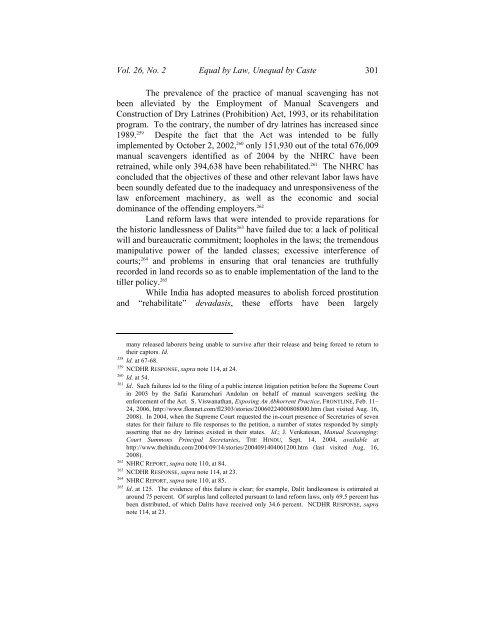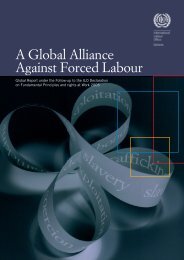equal by law, unequal by caste - International Dalit Solidarity Network
equal by law, unequal by caste - International Dalit Solidarity Network
equal by law, unequal by caste - International Dalit Solidarity Network
Create successful ePaper yourself
Turn your PDF publications into a flip-book with our unique Google optimized e-Paper software.
Vol. 26, No. 2 Equal <strong>by</strong> Law, Un<strong>equal</strong> <strong>by</strong> Caste 301The prevalence of the practice of manual scavenging has notbeen alleviated <strong>by</strong> the Employment of Manual Scavengers andConstruction of Dry Latrines (Prohibition) Act, 1993, or its rehabilitationprogram. To the contrary, the number of dry latrines has increased since1989. 259 Despite the fact that the Act was intended to be fullyimplemented <strong>by</strong> October 2, 2002, 260 only 151,930 out of the total 676,009manual scavengers identified as of 2004 <strong>by</strong> the NHRC have beenretrained, while only 394,638 have been rehabilitated. 261 The NHRC hasconcluded that the objectives of these and other relevant labor <strong>law</strong>s havebeen soundly defeated due to the inadequacy and unresponsiveness of the<strong>law</strong> enforcement machinery, as well as the economic and socialdominance of the offending employers. 262Land reform <strong>law</strong>s that were intended to provide reparations forthe historic landlessness of <strong>Dalit</strong>s 263 have failed due to: a lack of politicalwill and bureaucratic commitment; loopholes in the <strong>law</strong>s; the tremendousmanipulative power of the landed classes; excessive interference ofcourts; 264 and problems in ensuring that oral tenancies are truthfullyrecorded in land records so as to enable implementation of the land to thetiller policy. 265While India has adopted measures to abolish forced prostitutionand “rehabilitate” devadasis, these efforts have been largelymany released laborers being unable to survive after their release and being forced to return totheir captors. Id.258 Id. at 67-68.259 NCDHR RESPONSE, supra note 114, at 24.260 Id. at 54.261 Id. Such failures led to the filing of a public interest litigation petition before the Supreme Courtin 2003 <strong>by</strong> the Safai Karamchari Andolan on behalf of manual scavengers seeking theenforcement of the Act. S. Viswanathan, Exposing An Abhorrent Practice, FRONTLINE, Feb. 11–24, 2006, http://www.flonnet.com/fl2303/stories/20060224000808000.htm (last visited Aug. 16,2008). In 2004, when the Supreme Court requested the in-court presence of Secretaries of sevenstates for their failure to file responses to the petition, a number of states responded <strong>by</strong> simplyasserting that no dry latrines existed in their states. Id.; J. Venkatesan, Manual Scavenging:Court Summons Principal Secretaries, THE HINDU, Sept. 14, 2004, available athttp://www.thehindu.com/2004/09/14/stories/2004091404061200.htm (last visited Aug. 16,2008).262 NHRC REPORT, supra note 110, at 84.263 NCDHR RESPONSE, supra note 114, at 23.264 NHRC REPORT, supra note 110, at 85.265 Id. at 125. The evidence of this failure is clear; for example, <strong>Dalit</strong> landlessness is estimated ataround 75 percent. Of surplus land collected pursuant to land reform <strong>law</strong>s, only 69.5 percent hasbeen distributed, of which <strong>Dalit</strong>s have received only 34.6 percent. NCDHR RESPONSE, supranote 114, at 23.
















